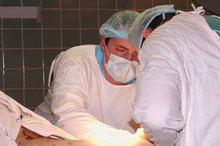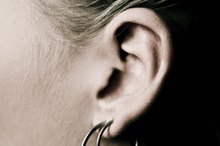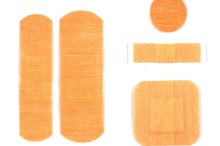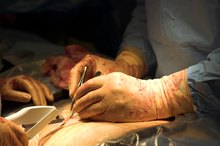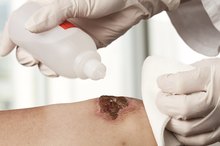How Long Do Surgical Staples Stay In?
Surgical staples, tissue adhesives, surgical tape and sutures are widely used methods to close surgical wounds or trauma injuries 2. More commonly used with larger, deeper wounds, surgical staples are faster to apply than sutures -- or stitches, and associated with fewer wound infections, according to a September 2011 report in "The American Surgeon." While internally used staples are designed to stay in the body, external stitches are removed after the incision is healed.
Staple Use
Surgical staples are typically made of stainless steel or titanium, and come in many different sizes and lengths. They can be curved, circular or strait, and can be thin and flexible -- but strong. Internal staples, which are typically titanium-based, are used during surgery to clamp blood vessels, connect internal tissues or reconstruct organs. Surgical staples are also used externally to close large, deep trauma wounds or surgical incisions, and are commonly used for scalp lacerations or to close the surgical cuts from orthopedic surgery.
- Surgical staples are typically made of stainless steel or titanium, and come in many different sizes and lengths.
- Surgical staples are also used externally to close large, deep trauma wounds or surgical incisions, and are commonly used for scalp lacerations or to close the surgical cuts from orthopedic surgery.
Staple Removal
Types of Surgical Staples Used Internally
Learn More
Surgical staples are ready to be removed when the sewn tissue has healed well enough that the staples are no longer needed. Also, it's important that no drainage is noticed, and there are no signs of infection. The removal procedure requires specialized equipment and skill, and needs to be completed by a healthcare professional in a sterile environment, such as a hospital or medical clinic. Staples are usually removed 7 to 14 days after they are placed, but this length of time depends on the healing rate, as well as the size and depth of the wound. Your doctor may err on the side of caution, and keep your staples in longer if there is any concern that the wound is not healed enough to remove this support.
- Surgical staples are ready to be removed when the sewn tissue has healed well enough that the staples are no longer needed.
- Your doctor may err on the side of caution, and keep your staples in longer if there is any concern that the wound is not healed enough to remove this support.
Warnings
The decision on when to remove the staples is an important one, as removing them too early can cause the wound to reopen, and increase the risk of infection. Follow care instructions provided by your doctor, which will include guidance on bathing and caring for your wound area. Don't try to remove the staples yourself, as this can risk infection, additional scarring -- and can be painful. If you have recently had sutures or staples placed, and have a fever, redness, pain or an unpleasant smell or pus coming from the wound area, see your doctor right away. Also, if you have any questions about the removal of your surgical staples, ask your doctor.
Reviewed by Kay Peck, MPH RD
- The decision on when to remove the staples is an important one, as removing them too early can cause the wound to reopen, and increase the risk of infection.
- Don't try to remove the staples yourself, as this can risk infection, additional scarring -- and can be painful.
Related Articles
References
- Advance Healthcare Network for NPs and PAs: Surgical Staples for Scalp Laceration Repair
- The American Surgeon: Sutures Versus Staples for the Management of Surgical Wounds: A Meta-Analysis of Randomized Controlled Trials.
- Central Infusion Alliance: Everything Healthcare Professionals Need to Know About Surgical Staples
- 3M Wound Resource Center. http://solutions.3m.co.uk/wps/portal/3M/en_GB/skin-care/wound-resource-centre/
- Mccaughan D, Sheard L, Cullum N, Dumville J, Chetter I. Patients' perceptions and experiences of living with a surgical wound healing by secondary intention: A qualitative study. Int J Nurs Stud. 2018;77:29-38. doi:10.1016/j.ijnurstu.2017.09.015
- Krafts KP. Tissue repair: The hidden drama. Organogenesis. 2010;6(4):225-33. doi:10.4161/org.6.4.12555
- Chetter IC, Oswald AV, Fletcher M, Dumville JC, Cullum NA. A survey of patients with surgical wounds healing by secondary intention; an assessment of prevalence, aetiology, duration and management. J Tissue Viability. 2017;26(2):103-107. doi:10.1016/j.jtv.2016.12.004
- Singh PK, Saxena N, Poddar D, et al. Comparative Study Of Wound Healing In Primary Versus Delayed Primary Closure In Contaminated Abdominal Surgery. Hellenic J Surg. 2016;88:314–320. doi:10.1007/s13126-016-0340-8
- Surgical Patient Education Program: Prepare for the Best Recovery. American College of Surgeons. 2018.
- Rushbrook JL, White G, Kidger L, Marsh P, Taggart TF. The antibacterial effect of 2-octyl cyanoacrylate (Dermabond®) skin adhesive. J Infect Prev. 2014;15(6):236-239. doi:10.1177/1757177414551562
- Lazar HL, Mccann J, Fitzgerald CA, Cabral HJ. Adhesive strips versus subcuticular suture for mediansternotomy wound closure. J Card Surg. 2011;26(4):344-7. doi:10.1111/j.1540-8191.2011.01257.x
- 3M Wound Resource Center.
Resources
Writer Bio
Ken Chisholm is a freelance writer who began writing in 2007 for LIVESTRONG.COM. He has experience in health care, surgery, nursing and orthopedics as an orthopedic physician assistant and a registered nurse. He holds a bachelor's degree in business from the University of Findlay, Ohio.

